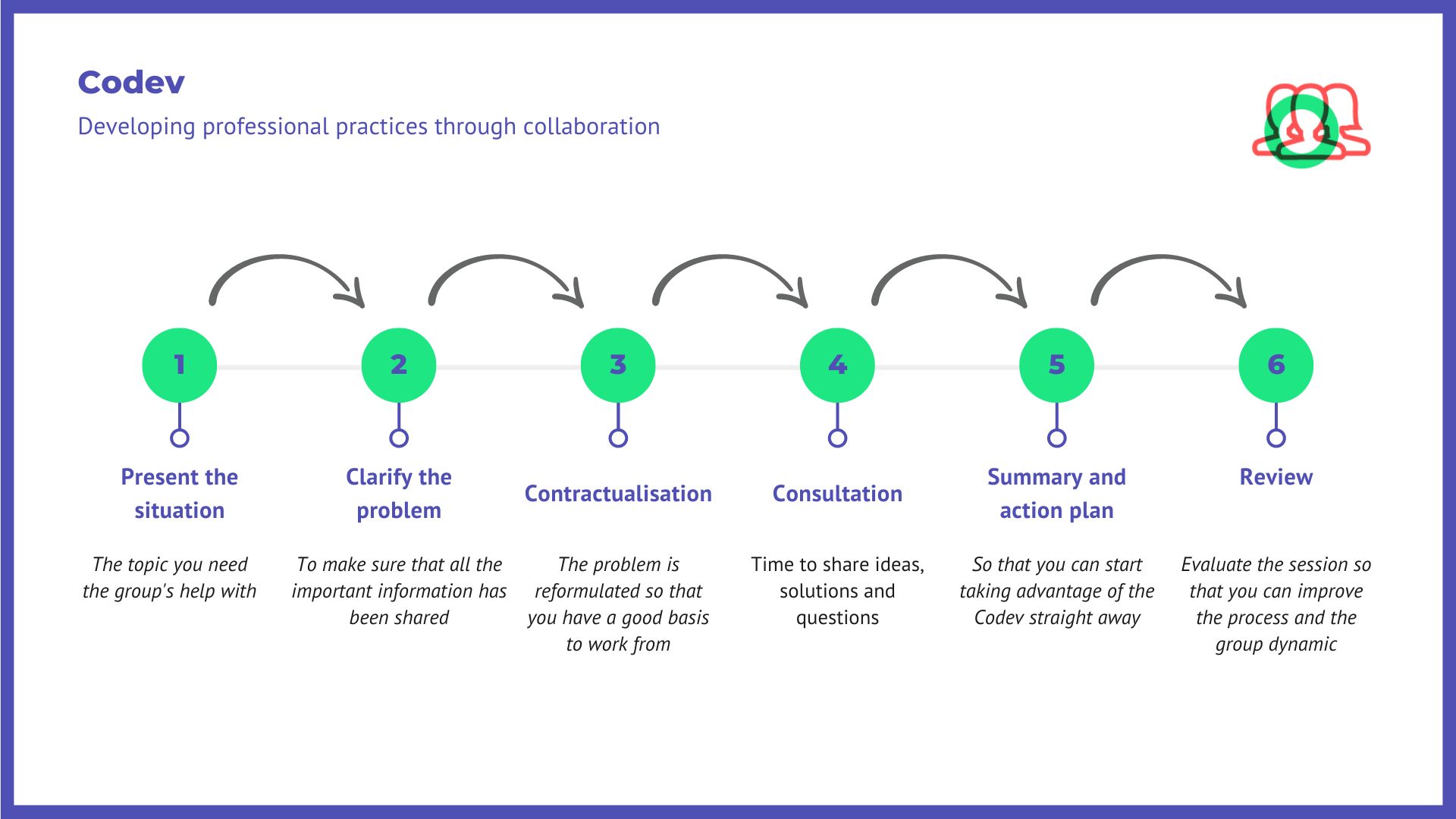To save colors and take care of the planet, print this text in shades of gray
Codev
Develop professional practices through collaboration
Pratique
Aim
Co-development (or Codev) is a method that was developed in the ‘90s by teacher Adrien Payette and consultant-trainer Claude Champagne.
The main aim of Codev is to create a learning community amongst peers where they can perfect their practices or resolve any problems, drawing on facts and real-life situations.
The ideal Codev group is formed of 6 to 8 individuals who commit to meeting for a pre-defined number of sessions, which generally last between 1.5 hours and half a day.
Through clearly defined stages, Codev can be used to help anyone with a problem, project or concern through a collaborative approach based on the spontaneous, voluntary input of the other members of the group, called the “consultants”.
The benefit of this process is that it prevents us from rushing straight towards the solution. It forces us to take the broader context into account and generate lots of ideas in a small amount of time, which is of course beneficial for the person with the problem, but can also be inspiring for the rest of the group too.
Instructions
Time needed: 1.5 hours or more
Materials:
- A calm and comfortable space where the participants can sit in a circle
- Something to take notes with for each participant
The notion of empathy is essential for a successful Codev session, so encourage the participants to listen carefully and with kindness.
Kindness is also one of the four key rules of co-development (which you could also remind the group of):
- confidentiality
- kindness
- truthfulness
- commitment
Key steps
As an introduction, present the aim of Codev and the mindset it requires. You can then invite each participant to express their need as the “client” and get the group to vote for the topic they’d like to address during the session.
Next, read the instructions. Regularly check in to make sure that they are being respected and keep an eye on the time. As facilitator, it’s best if you don’t take part as a consultant so that you can focus on the process and the group dynamic.
- Presentation [5 mins]
The client presents their need to the consultants, i.e. a problem, project, or concrete concern, in as much detail and as clearly as possible.
The consultants listen and take notes, without asking any questions or interrupting the client. - Clarification [10 mins]
The consultants ask questions in order to clarify certain aspects (without judging or making any suggestions).
The client replies to each question. - Contractualisation [5 mins]
With the help of the consultants, the client defines a new question if necessary, and reformulates their needs: “What I need from you is [their need]”. - Consultation [20 mins]
Go around the table and ask each consultant to share their impressions and give any comments, ideas, suggestions and advice, and raise any new questions.
The client listens and notes down what the others say, without reacting or responding at this stage. - Summary and action plan [10 mins]
The client takes 1 to 2 minutes to themselves to digest the ideas, suggestions and advice provided by the consultants. They reformulate them if necessary, before sharing what they have taken on board.
They then draw up an action plan, which the others may also contribute to. - Feedback [5 to 10 mins]
Go around the table again and ask the participants (clients and consultants) to express what they have learnt from the experience.
Together, they evaluate the Codev session: how well the group has listened, what worked and what didn’t work, what they’ll do differently next time, etc.

Tips and advice
- You can carry out more than one Codev process during a single meeting.
- You’ll find you can supervise several at once if the groups are already used to using the method and can master it independently. They can also ask for help if they’re stuck or have a question about the process.
- Ask the participants to think about their individual impact on the group (not taking over, accepting different opinions, etc.)
- It’s important that the time set aside in advance for each stage is respected. This can sometimes be frustrating, but having a limit encourages the participants to focus on what’s really important.
- Although the idea behind Codev is to work with the same group of peers over a period of time, you can also use the method to explore any problem at any given moment.
- It’s the consultants’ experiences that help to resolve the client’s problem, rather than their expertise.
- It’s essential that the client takes note of everything they hear during the session. They won’t be able to absorb all the information there and then. Reading it again fresh will enable them to benefit even more from the Codev session.